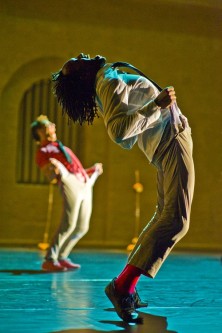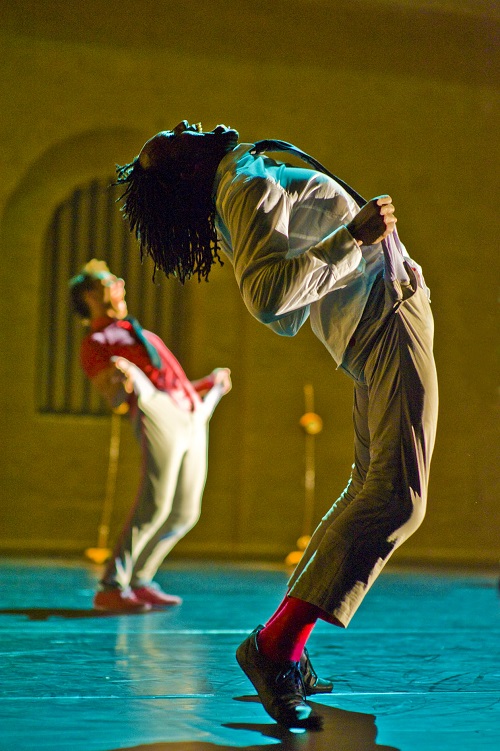 United States Various composers, Compagnie Käfig: Dorothy Chandler Pavilion, Los Angeles, 17.6.16. (JRo)
United States Various composers, Compagnie Käfig: Dorothy Chandler Pavilion, Los Angeles, 17.6.16. (JRo)

Dancers: Diego Alves Dos Santos, known as Dieguinho; Leonardo Alves Moreira, known as Leo; Cleiton Luiz Caetano De Oliveira; Aguinaldo De Oliveira Lopes, known as Anjo; Helio Robson; Dos Anjos Cavalcanti; Geovane Fidelis Da Conceição; Diego Gonçalves Do Nascimento Leitão, known as White; Wanderlino Martins Neves, known as Sorriso; Jose Amilton Rodrigues Junior, known as Ze; and Alexsandro Soares Campanha Da Silva, known as Pitt.
Production:
Käfig Brasil
Artistic Direction: Mourad Merzouki
Choreographies: Collectif Käfig Brasil, Denis Plassard, Céline Lefèvre, Octavio Nassur, Anthony Egéa, Mourad Merzouki
Musical Arrangements: AS’N, Guide Nibo Desandamm, Korobushka – group Bond, Vuelvo al sur – Groupe Gotan Project
Music: Vivaldi, Dinho Nascimento, Guy Monk, Ame, Camille, The Lushlife Project, AS’N, Deadmau5, Emmanuel Santarromana
Lighting Design: Yoann Tivoli, assisted by Cécile Robin
Stage Design: Mourad Merzouki and Yoann Tivoli
Costume Design: Emilie Carpentier
Props: Samuel Chenier
Agwa
Choreographer: Mourad Merzouki
Assistant choreographer: Kader Belmoktar
Music Design: AS’N
Music: AS’N, Guide Nibo Desandamm, Korobushka – groupe Bond, Vuelvo al
sur – Groupe Gotan Project
Lighting Design: Yoann Tivoli
Stage Design: Mourad Merzouki and Benjamin Lebreton
Costume Design: Angèle Mignot
The stage of the Dorothy Chandler Pavilion came alive with the insistent pulse of ten male bodies bouncing, spinning, flipping, and diving. Mourad Merzouki’s company of Brazilian dancers, Compagnie Käfig, turned street dance into a joyful theatrical performance, and in the process made an artistic, political, and social statement concerning the planet’s dwindling resource, water.
Agwa (Water) was a treasure trove of the imaginative possibilities of plastic cups. As much a museum-worthy, kinetic performance piece as a staged contemporary dance work, Agwa is the perfect blending of Merzouki’s concerns. Hip-hop, Brazilian Capoeira, Samba, Bossa Nova, and circus acrobatics combined to form a whimsical exploration of the use of a cheap material, plastic, that is carelessly discarded into the environment, but is also a container for our most precious resource, water.
One dancer inhabited the stage, along with what appeared to be glass columns of varying heights. The air currents set up by his motion toppled a few columns, and it was then we realized these were stacks of plastic cups. Accompanied by the recorded Haitian rhythms of Guide Nibo Desandamm, an ensemble from Cuba, what followed was both life-supporting and a clear-eyed look at the necessity of a drop of water. As more dancers rushed in, more cups toppled. They were reassembled into a low-lying grid on the floor, and dancers deftly performed a dazzling array of steps in their midst, hurling themselves between the lines of cups.
But movement wasn’t restricted to obvious hip-hop body contortions. In one sequence, as the dancers lay on their stomachs, highlighted by the exquisite lighting of Yoann Tivoli, their hands crept and darted around the cups. With Chaplinesque verve, Merzouki created a line dance of what seemed like agile keyboard artists. Water was poured to humorous effect, cups were restacked, creating a giant slinky, and in one hilarious segment, clear plastic, sleeveless raincoats with pointy hoods were donned, as dancers anticipated an approaching storm. The sounds of running water enhanced the mood. Invention piled on invention as the high-spirited group danced to the electronic strains of Russian folk dance and the sultry sounds of Gotan Project.
Trained from age 7 at the circus school of St. Priest in a Lyon suburb, at 15 Merzouki turned to dance, inspired by hip-hop culture. His troupe, Compagnie Käfig, founded in 1996, is notable for combining a global world-view with popular forms of dance. These were on display in the first piece of the evening, Käfig Brasil, choreographed by Merzouki in collaboration with his company and four other choreographers. Elbows jutting, heads circling, and torsos quivering in the more classic language of hip-hop, the dancers offered an impassioned and visceral look at the disenfranchised youth of the world’s urban centers.
With this elastic and electric troupe, the evening became a celebration of the very human urge to create joy amid turmoil by dancing your heart out.
Jane Rosenberg
